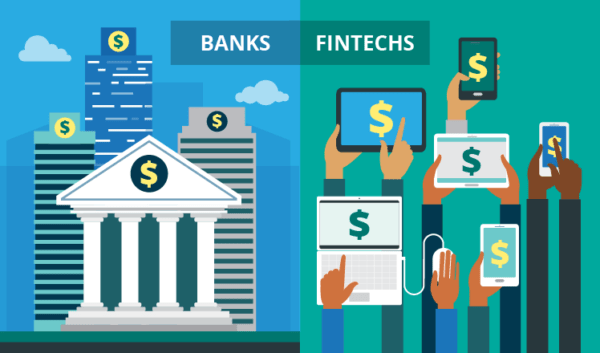FinTech: Changing the Face of Indian Banking

FinTech: Changing the Face of Indian Banking
FinTech is a broad word used to digitise and streamline financial services. It was developed utilising finance and technology. The same idea underlies the ability to quickly cash a check by taking a picture of it using a smartphone. You can also use online UPI applications to pay for meals, thanks to technology. Fintech has dramatically affected our daily lives, despite the fact that we hardly ever realise it. It can also be incorporated into new sectors due to its enormous potential.
The digital trend in India has led to exponential growth in the FinTech sector.
In India, there are already over 2100 FinTech startups. Only in the past five years have 67 per cent of these businesses begun to operate! By 2025, the Indian FinTech market share is anticipated to be over $150 billion.

What is FinTech?
FinTech can be roughly defined as a development in software or technology that relates to essential financial services and is used on both computer and mobile platforms. It also includes hardware that enables users to conduct financial transactions, such as virtual reality trading platforms or innovative piggie banks.
With the help of fintech, users may complete numerous daily financial operations like check deposits, bill payments, money transfers, and loan applications. It also includes other difficult jobs like peer-to-peer lending and cryptocurrency trading.
Banks and other financial institutions use fintech for back-end and interface applications. They utilise it for behind-the-scenes tasks like monitoring your financial transactions and offering client-centred solutions. Fintech can be used by customers for various tasks, from completing income tax returns to making novice stock market investments.
Every industry, business style, and target demographic can benefit from financial technology. Fintech is used by businesses to process payments, handle bookkeeping, develop e-commerce applications, etc. Many companies rely on fintech because of its cutting-edge features like contactless transactions and other technology-backed advances in place of the plague.
Examples of FinTech
Several well-known businesses, including Personal Capital, Lending Club, Kabbage, and Wealthfront, have developed FinTech businesses in the last ten years. These businesses offer fresh takes on financial ideas and give customers more control over their financial results.
-
Digital Lending and Credit
FinTech behemoth Kabbage uses transactional data to support its direct funding of small business loans and lightning-fast lending choices. Lending Club uses peer-to-peer lending to enable users to fund business endeavours without the assistance of a traditional financial institution (P2P lending). Big Data and sophisticated analytics applied across digital platforms allow each of these advancements.
Credit Karma is an example of a FinTech in the expanding sector of credit reporting that offers a service (free credit reports) in exchange for the right to market loans and credit cards suited to the individual requirements of its consumers.
-
Mobile Banking
Many financial institutions are implementing or enhancing their mobile banking capabilities in response to the growing consumer demand for digital banking as consumers focus more on financial wellbeing. Today, most banks provide mobile banking functionality on their website.
-
Mobile Payments
Any individual under 30 who is asked how they prefer to pay is likely to respond that mobile apps are the best option. Peer-to-peer services like Venmo have emerged to replace conventional payment methods as our society has transitioned from a cash-based one to one that is more and more digital. It’s predicted that global mobile point of sale sales will reach $5.4 billion in 2018 alone.
-
Cryptocurrency & Blockchain
Users buying or selling cryptocurrencies like bitcoin can connect through cryptocurrency exchanges. By preserving provenance information on the blockchain, blockchain solutions have sought to decrease fraud.
-
Insurance
The term “insurtech” refers to the application of technology to the insurance sector in order to increase efficiency and optimise savings. By revolutionising time-consuming procedures like underwriting, claims processing, and quick activation, insurtechs are redefining the insurance consumer experience. To automate processes and allow the insurance companies to increase coverage, fintech businesses are beginning to collaborate with established insurance providers.
-
Trading
With the use of FinTech, trading and investment have improved. Without the aid of AI technologies, extensive data information is frequently unorganised and unintelligible. Using natural language processing, these technologies can quickly sort through large databases and draw conclusions from the data. Trades can now discover trends and hazards by processing massive volumes of data through algorithms.
-
Banking as a Service (BaaS)
FinTechs can offer the goods and services of a financial institution under their own brand by using banking-as-a-service, often known as white-label banking. A financial institution charges a fee for FinTech to use its BaaS platform, banking licence, regulatory knowledge, and services for lending, payments, mobile bank accounts, debit cards, fraud management, and other things.

Evolution of FinTech
Fintech is not Gen-Z slang, despite the term sounding like it. Despite the fact that the phrase was added to the language in 2018, the fundamental idea has roots that stretch back many years. For instance, signature-verifying systems, which were initially utilised by the banking industry in the late 1800s, and ATMs were long regarded as the pinnacle of fintech advancements.
The fintech sector has recently developed from small startups to one of the main pillars of large organisations and global corporations. Fintechs had joined forces with the institutions they were meant to replace, unlike earlier when the phrase was only connected with a few startups upending established banking institutions.
While other industries struggled, the fintech sector showed its value even during the global shutdown. For instance, by utilising fintech-backed innovations, the nation’s banking institutions could still engage and conduct business with their consumers even while temporarily closed. Additionally, users were able to obtain customer service services online and bypass the lengthy wait times.

How Does Fintech Affect Customers?
By itself, the financial sector does not have an excellent reputation for adaptability and skill. But in the financial industry today, getting results quickly keeps customers returning.
Fintech’s effects have the potential to enhance the idea of financial inclusion. Fintech fills the gap left by traditional banking or financial support for the bulk of our people, which is unbanked.
Because the entire idea is built around programming language against the most fundamental human logic, fintech has consistently been able to streamline traditional core banking services. Even though the majority of fintech solutions combine features of traditional bankers and sophisticated computer codes, they enable regular people to complete complicated financial activities without having to deal with bankers directly.

How is Fintech Evolving the Indian Banking Sector?
The banking sector has evolved throughout time from a physical to a digital system. The way the nation views the financial system is changing as a result of the cutting-edge technologies deployed by fintech companies.
The KYC, Aadhaar Card, card-less money withdrawals, and online customer onboarding are a few examples of technologically supported systems that point to the digitalisation of the Indian banking sector.
Let’s look at the 5 main ways fintech is transforming the Indian banking sector:
1. Futuristic Self-Service Technologies
The days of waiting in line for the most minor procedures, like submitting a form, are over. Self-service solutions now allow users to access procedural portals that were previously only available by physically visiting a branch, thanks to the development of fintech.
Fintech technologies also provide essential banking services, including loans, insurance, and account opening, in addition to online money transfers. With only one click, all of the stuff is accessible!
In addition to learning how to make wiser financial decisions for themselves and their loved ones, this helps the client by giving them a clear picture of their financial credibility.
2. Intuitive Application Programming Interface
The Reserve Bank of India implemented NEFT, IMPS, and RTGS about ten years ago in an effort to simplify money transfers and other banking procedures for the consumer. The launch of financial applications powered by an Application programming interface (API) came shortly after that. The banking industry operates as follows:
• To perform transactions seamlessly and digitally, banks must integrate their products with those of third parties.
• The banks will require API technology in order to connect their goods to outside providers.
• In a nutshell, API serves as a middleman to facilitate real-time connections between financial institutions and outside parties and to complete challenging jobs.
• One of the most prevalent examples of fintech’s daily use is the money transfer requests made by online UPI applications and received by the institutions. This gives the user a quicker and more seamless experience.
• APIs allow third-party businesses and financial institutions to complement each other’s specialities and to offer cutting-edge services and products to the customer in a streamlined and organised way.
3. Instant Payment Features
Point of sale terminals has only recently begun to appear, even though the majority of the population in our nation has relied on cash for payments for the past ten years.
Following this, mobile internet services rapidly increased in availability, and demonetisation led to the country adopting digital payments.
When citizens opt to use digital payment methods, the central government has started rewarding them with additional perks. To make India more cash-free and to quickly adopt new technology, the issues caused by KYC bottlenecks were solved.
Currently, sending or receiving money via a cell phone simply takes a few seconds, revolutionising how India spends its money and fostering an accountability system.
4. Automated Voice Bots for Customer Service
Due to the adoption of fintech, numerous banks have introduced their own AI chatbots for client relationship management. The conventional chatbot system was replaced with this one. These intelligent solutions are created in a way that uses speech recognition and natural language processing to help and support clients.
Similar to how Netflix and other customer-focused products have been integrated, speech bots are also being used in the financial services sector. Imagine being able to create a new passcode or start a new bank account in a matter of minutes solely by using voice commands.
5. Neobanking
The emergence of Neobanking is one of the significant changes that fintech has wrought in the banking industry. Neobanks are defined as banks that only exist online and don’t have any physical locations.
These financial institutions provide a wide range of essential banking services, including lending products, mutual funds, fixed deposits, savings accounts, and loans, all of which are easily accessed online through desktop and mobile applications. This tendency has evolved with more people seeking quick digital banking options during the pandemic.

The Future of Fintech: Expanding Horizons
Currently, the fintech sector has been providing a range of services under one roof. On the other hand, given the global upheaval brought on by the Covid-19 outbreak, no one can say for sure what the future holds for the fintech business. Any assumptions about the near future of the fintech market have been altered by the interest rate subsidies and the uncertainty related to the coronavirus.
Many fintech businesses have experienced losses, just like their clients, while many others are frantically seeking large investor capital. As businesses and banking consumers rely more than ever on technology to help them navigate their financial situation, the need for creative fintech has been at an all-time high.
However, the long-term objectives of this industry are still largely intact. Traditional financial providers are now starting to form alliances and consolidated relationships, which had always been expected. Fintech integration has increased to a new level with the announcement by the Central Government that laws for the cryptocurrency market would be included in the Union Budget for 2022–2023. The typical banking consumer can anticipate the launch of a number of new cutting-edge financial goods and services, including peer-to-peer lending, blockchain technology, and cryptocurrencies.
In Conclusion
Prior to the development of fintech, the majority of individuals found doing banking operations physically to be a difficult undertaking. The telecommunications industry and the pandemic helped to fuel the growth of the banking sector even though it took decades to digitise.
FinTech is anticipated to give businesses the opportunity to spearhead the digitisation wave throughout a value chain that includes far more than simply a mobile application in 2022. The rapid rate at which the concept is being adopted may alter the financial sector’s cost structure while offering customers innovative products.
Article proofread & published by Gauri Malhotra.




